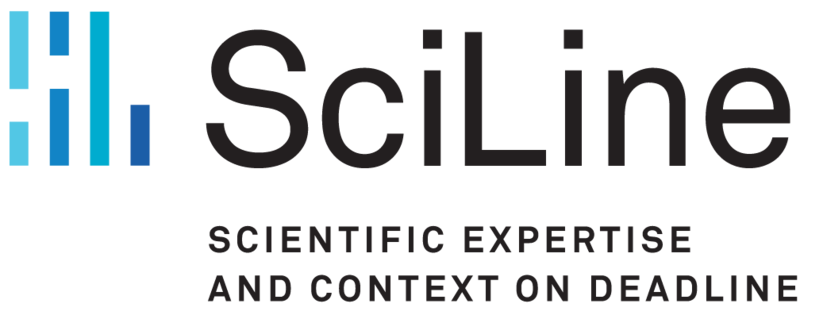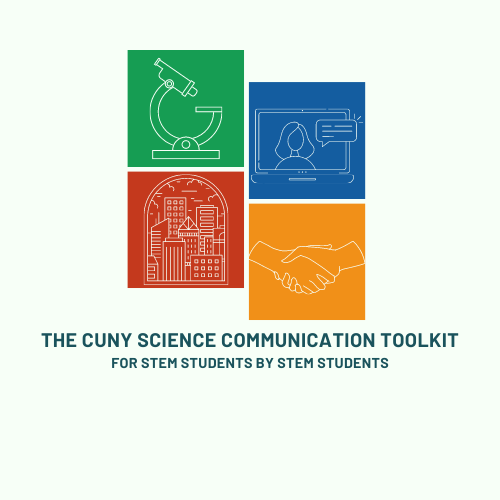Media Engagement
 Speaking with journalists and being active on social media is an integral part of science communication. By working with the press or posting to Twitter, Instagram and other platforms, you can reach a larger, more diverse group of people. There is also evidence that media engagement can contribute to one’s scientific impact. Here are some tips, tools and other resources for getting media coverage of your research, preparing for an interview with a journalist, and using social media platforms for public-facing communications.
Speaking with journalists and being active on social media is an integral part of science communication. By working with the press or posting to Twitter, Instagram and other platforms, you can reach a larger, more diverse group of people. There is also evidence that media engagement can contribute to one’s scientific impact. Here are some tips, tools and other resources for getting media coverage of your research, preparing for an interview with a journalist, and using social media platforms for public-facing communications.
GC Science Communication Academy
Communicating complex science can prove challenging, but the GC Science Communication Academy offers tips, worksheets and resources for talking to media, creating lay friendly talking points, writing op-eds and more.
SciLine
 Run by the AAAS, SciLine is an editorially independent, philanthropically funded, free service connecting journalists with scientific experts around the world. SciLine is a database of scientists (which you can sign up to be included in!) that journalists can consult if they have questions about a particular topic for a story. SciLine also hosts workshops and “boot camps” to build links between scientists and journalists, and to help scientists become better communicators. Scientists can also submit a “tip” (a story idea) that is shared with reporters on SciLine if they need ideas for scientific content.
Run by the AAAS, SciLine is an editorially independent, philanthropically funded, free service connecting journalists with scientific experts around the world. SciLine is a database of scientists (which you can sign up to be included in!) that journalists can consult if they have questions about a particular topic for a story. SciLine also hosts workshops and “boot camps” to build links between scientists and journalists, and to help scientists become better communicators. Scientists can also submit a “tip” (a story idea) that is shared with reporters on SciLine if they need ideas for scientific content.
Media Engagement Tips
 So, you were just contacted by a journalist who’s looking for you to shed light on a topic specific to your field of research? Here are a few tips to help you talk to reporters and prepare for interviews. The pandemic and infectious disease are currently the dominating science new. Here are some guidelines for speaking on pandemic-specific topics even if you don’t feel you have the specific expertise.
So, you were just contacted by a journalist who’s looking for you to shed light on a topic specific to your field of research? Here are a few tips to help you talk to reporters and prepare for interviews. The pandemic and infectious disease are currently the dominating science new. Here are some guidelines for speaking on pandemic-specific topics even if you don’t feel you have the specific expertise.
Find tips on additional related topics below:
- Working with Journalists, TV & Radio
- Communicating with the Press
- Creating Op-Eds (get additional writing tips from the OpEd Project)
- Getting Media Coverage
- Guide to writing press releases
 In order for science to influence policy decisions, lawmakers must be informed on the latest scientific practices in industry, academia, and medicine. Scientist must bridge the gap between policy and science by finding effective language and methodology that will get politicians to listen.
In order for science to influence policy decisions, lawmakers must be informed on the latest scientific practices in industry, academia, and medicine. Scientist must bridge the gap between policy and science by finding effective language and methodology that will get politicians to listen.
- Look to SEPANYC for resources on bridging the gap between science and policy
- “Want to get a politician to listen to science?” Here is some advice.
- The Union of Concerned Scientists is a scientist-led non-profit lobbying for science-based policy
- Check out the Engaging Scientists & Engineers in Policy Coalition, an ad hoc alliance of organizations working to engage in the policy making process at all levels of government
Communicating with the general public and peers alike, has proven useful in raising awareness on scientific research and academic discovery. Social media is one component of communication that has endless reach and influence. Therefore, we have collated resources that may assist in your outreach endeavors.
Social Media for Scientists
Most scientist are not big on promoting themselves and are solely fascinated with discovery. However, to effectively communicate on social media, a scientist must learn to promote his/her work and platform. Here is how!

As a scientist on social media it is important to be familiar with different platforms and their utilization. To expand social engagement, one must have a clear understanding of the target audience, demographics, and effective repetition. Here is a guide to social media for scientists. Kendra Krueger, ASRC Science Education Coordinator, has also developed a guide for building a social media campaign.
Additional resources:
- A science guide to social media campaigning
- How to use social media as a scientist?
- How to use Twitter
- Tips from Coralie Carlson, CUNY Graduate Center Social Media Manager:
– Need help getting down the social media basics?
– To make the most of Twitter you may need help navigating your professional digital identity.
– You’ve just finished your research and now you need help sharing it with the scientific community: promoting on social media can help.
Creating Videos for Social Media
The Scientist Videographer is a website and tool for scientist just stepping into documentarian style videos , film-making, or video-blogging. It is a quick-tip guide that starts off with video basics and transitions into expanding an audience.
In order to convey complex science to a wider audience we must conceptualize it in a way most people can understand; Film-making is no different. The Swiss Science Film Academy offers links to workshops, for film-making as a scientist.
The Science & Entertainment Exchange connects entertainment industry professionals with scientists & engineers to bring accurate science into film and TV programming.
ScienceTalk is a professional society that empowers and inspires science communicators to reach audiences across platforms and media.
NPR SciCommers is a community of 1600+ scientists at all career stages interested in improving their science communication skills. They provide mentorship opportunities with media professionals, Slack channels tied to specific communication platforms and a pitch program where scientist can practice writing press releases.
The Thought Project is a CUNY Graduate Center podcast and Medium publication featuring interviews and blogs where faculty and students talk about their research and scholarship for a public audience. You can check out the guidelines and learn how to contact the producers/editors by visiting their page.
Independent news organization The Conversation is a great place to start getting involved in “explanatory journalism.” Academics can submit articles for the general public that are collaboratively edited by the organization’s seasoned journalists.


